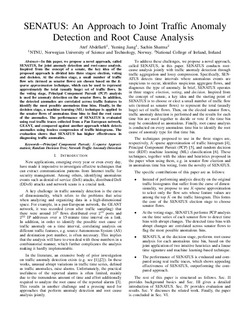| dc.contributor.author | Abdelkefi, Atef | |
| dc.contributor.author | Jiang, Yuming | |
| dc.contributor.author | Sharma, Sachin | |
| dc.date.accessioned | 2019-04-05T12:19:02Z | |
| dc.date.available | 2019-04-05T12:19:02Z | |
| dc.date.created | 2019-01-16T09:51:36Z | |
| dc.date.issued | 2018 | |
| dc.identifier.isbn | 978-1-5386-7045-3 | |
| dc.identifier.uri | http://hdl.handle.net/11250/2593539 | |
| dc.description.abstract | In this paper, we propose a novel approach, called SENATUS, for joint anomaly detection and root-cause analysis. Inspired from the concept of a senate, the key idea of the proposed approach is divided into three stages: election, voting and decision. At the election stage, a small number of traffic flow sets (termed as senator flows) are chosen based on the Ksparse approximation technique, which can be used to represent approximately the total (usually huge) set of traffic flows. In the voting stage, Principal Component Pursuit (PCP) analysis is used for anomaly detection on the senator flows. In addition, the detected anomalies are correlated across traffic features to identify the most possible anomalous time bins. Finally, in the decision stage, a machine learning (ML) technique is applied to the senator flows of anomalous time bins to find the root cause of the anomalies. The performance of SENATUS is evaluated using real traffic traces collected from a Pan European network, GEANT, and compared against another approach which detects anomalies using lossless compression of traffic histograms. The evaluation shows that SENATUS has higher effectiveness in diagnosing traffic anomalies. | nb_NO |
| dc.language.iso | eng | nb_NO |
| dc.publisher | Institute of Electrical and Electronics Engineers (IEEE) | nb_NO |
| dc.relation.ispartof | 2018 2nd Cyber Security in Networking Conference (CSNet) | |
| dc.title | SENATUS: An Approach to Joint Traffic Anomaly Detection and Root Cause Analysis | nb_NO |
| dc.type | Chapter | nb_NO |
| dc.description.version | acceptedVersion | nb_NO |
| dc.source.pagenumber | 1-8 | nb_NO |
| dc.identifier.doi | 10.1109/CSNET.2018.8602689 | |
| dc.identifier.cristin | 1657886 | |
| dc.description.localcode | © 2018 IEEE. Personal use of this material is permitted. Permission from IEEE must be obtained for all other uses, in any current or future media, including reprinting/republishing this material for advertising or promotional purposes, creating new collective works, for resale or redistribution to servers or lists, or reuse of any copyrighted component of this work in other works. | nb_NO |
| cristin.unitcode | 194,63,30,0 | |
| cristin.unitname | Institutt for informasjonssikkerhet og kommunikasjonsteknologi | |
| cristin.ispublished | true | |
| cristin.fulltext | preprint | |
| cristin.qualitycode | 1 | |
